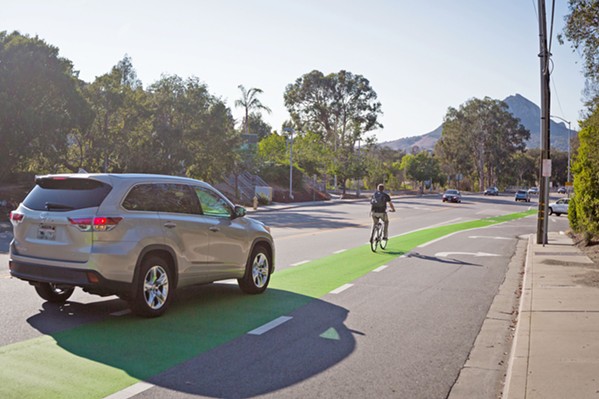Within the minutiae of San Luis Obispo's 157-page draft active transportation plan, one statement jumps out. In the next 10 years, the city expects to complete 100 percent of its highest priority bike and pedestrian projects.
That high-priority list is long and only 6.5 percent complete—it includes 52 projects, stretching dozens of miles and potentially costing more than $100 million.
At its core is a network of physically protected bike lanes, which will traverse busy arterial roads like Broad Street, Higuera Street, Marsh Street, Foothill Boulevard, Los Osos Valley Road, Madonna Road, and Tank Farm Road.

- File Photo By Kaori Peters
- NO VEHICLES VISION San Luis Obispo's draft active transportation plan includes more than 300 bike and pedestrian projects, with a goal to build 100 percent of the top-priority facilities by 2030.
According to SLO Active Transportation Manager Adam Fukushima, the plan's ambitious scope and timeline is directly related to the city's warp-speed goal of achieving net-zero greenhouse gas (GHG) emissions by 2035.
"What it comes down to is we have climate action goals, and transportation is the major source of GHG emissions," Fukushima told New Times. "So active transportation—converting a lot of the single occupancy vehicle trips to bike and pedestrian trips—is a huge part of that."
The plan divides more than 300 bike and pedestrian projects into three tiers—with Tier 1 featuring the highest priority projects. There's some community debate taking place about which projects are deserving of Tier 1 status.
"We're having a little bit of a philosophical debate," Fukushima said. "The debate we're seeing is what is the best way to reach those [climate and transportation] goals given the financial resources and time to get there."
Some residents want to see the city finish work on the Bob Jones Trail or the Railroad Safety Trail—building on trail networks that already exist. While elements of those projects are included in Tier 1, Fukushima said that costly, time-consuming factors, like acquiring land, make them more difficult to complete quickly.
That's why much of the Tier 1 approach involves installing protected bike lanes on major city streets and adding more street crossing opportunities—with some new dedicated bike and pedestrian trails included, too. SLO leaders say these projects give them the best chance of seeing a major shift in how residents commute through town.
"That's where most services are and where people want to go to," Fukushima said.
While protected bikeways are also expensive—often exceeding $1 million per mile—Fukushima said some stretches will be financed by developers as part of new housing projects like San Luis Ranch and Avila Ranch.
The active transportation plan is open for public comment through Dec. 31. Over the next week, three separate city bodies will discuss it: the Active Transportation Committee on Dec. 3; the City Council on Dec. 8; and the Planning Commission on Dec. 9.
"This is sort of wrapping up almost three years of work," Fukushima said about the stretch of meetings, which will culminate in a final council vote in February 2021. Δ
Comments (3)
Showing 1-3 of 3